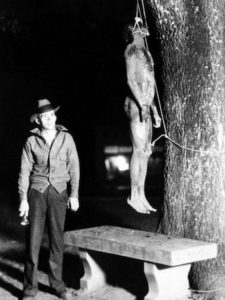
*Claude Neal was lynched on this date in 1934. His murder extended the American Red Summer episodes of assault on black men.
Claude Neal was a 23-year-old Black farmhand arrested in Jackson County, Florida, on October 19, 1934, for allegedly raping and killing Lola Cannady, a 19-year-old white woman missing since the preceding night. Circumstantial evidence was collected against him, but nothing directly linked him to the crime. When the news got out about his arrest, white lynch mobs began to form.
To keep Neal safe, County Sheriff Flake Chambliss moved him between multiple jails, including the county jail at Brewton, Alabama, 100 miles away. But a lynch mob of about 100 white men from Jackson County found out and brought him back to Jackson County. The time and place of the lynching were provided to the news media in advance and reported nationwide, attracting a huge crowd. The spectacle lynching had been announced at the Cannady farm, but the crowd had grown unruly, and a smaller group murdered Neal in secret. He was tortured and mutilated before being hanged by the instigators at a site along the Chattahoochee River near Greenwood, Florida.
They returned his body to the Cannady farm, where 2,000 whites attacked the corpse. Later that night, Neal's body was hanged from a tree in the courthouse square. On October 27. Photographers took souvenir photos of the body. When the sheriff discovered it in the morning, he cut it down. A mob formed outside the courthouse, with over two thousand people had arrived by noon, but they were too late to see Neal's body. Some purchased picture postcards of the corpse from photographers. The mob demanded that the sheriff hang Neal's body again outside the courthouse, but he refused.
Local whites started to riot. They attacked Blacks that day, injuring about 200 people caught on the street and injuring two police officers. Some whites protected black people whom they worked with. The mob headed into Black areas of town, looting and burning houses. The governor of Florida called out 120 troops of the Florida National Guard, which managed to suppress the riots. The brutal lynching of Claude Neal generated outrage in the rest of the country. Even in Florida, there was a reaction.
At the same time, Jessie Daniel Ames was organizing southern white women to oppose lynching and had obtained 40,000 signatures toward this goal. Neal's lynching was covered by the national press and provoked strong opposition across the nation. The lynching demonstrated the ineffectiveness of state and federal policies related to lynching, which were limited, as most southern states did not have laws against the practice. While some Americans sought to establish lynching as a federal crime, the Solid South block in Congress, which derived its power from having disenfranchised most Blacks across the South since the end of Reconstruction, consistently defeated any federal anti-lynching legislation.